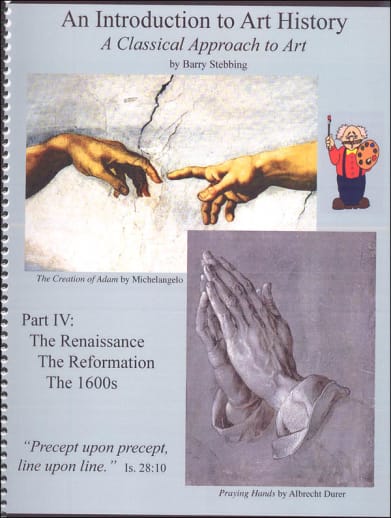Covers Cimabue, Giotto di Bondone, Fra Angelico, Correggio (The Pieta), Titian, Da Vinci, Michelangelo, Raphael, religious art, gothic style, Jan van Eyck, Albrecht Durer, Hieronymus Bosch, Lucas Cranach the Elder, Matthias Grunewald, Baroque Art, Rubens, El Greco, Pieter Bruegel, Anthony van Dyke, Rembrandt, Frans Hals, Vermeer, Willem Kalf, Jan Steen, Abraham Mignon, Pieter Goerritsz van Roestraten, Caravaggio, Bernini, Diego Velazquez, the eye, windows/natural light, warm/cool colors, drawing/shading with lines, point perspective, color wheel, and so much more
Classical Approach to Art History Course IV The Renaissance, The Reformation, & The 1600's
Description
In this, Part IV, of the series, Mr. Stebbing focuses on some of the more prominent artists and their styles during the time of the Reformation. We introduce some of the great masterpieces of the Italian Renaissance including the profound influence ancient Greece had on their style. Explore some great artists of the Reformation and their approach to art which, quite often, was different from the classical approach. Art Lessons come with each daily lesson, and include practical basics such as colored pencils, colored markers, and a drawing with a drawing pen. Ages 8 & up.
Subtitled A Classical Approach to Art, this series, directed to elementary and middle school students, pulls content from Barry Stebbing's four-year God and the History of Art course; reordering into different segments and adjusting lessons for a younger audience. Instruction is both classical and godly, and its user-friendly format will convince you that "I can do this." Courses are called Parts, which are each a full year's instruction in art history, art appreciation, and art projects. These can be done in any order allowing for coordination with other subjects and would be easy to adapt to a group or co-op setting. We currently have Parts I, II, and IV, expecting more by the end of the year. Courses include a Teacher's Guide with 36 detailed but brief lessons and quizzes plus sets of art lesson cards, and art masterpieces which are three-hole punched. You will need one set of these cards for each student. Art supplies, surprisingly few and simple, are the same for each course.
Lessons, found in the spiral-bound Teacher's Guide, include background information, examination of art time-periods or specific artists plus specific techniques. These lessons refer to the Masterpieces cards which are full-color reproductions of classic art pieces. The Art Lesson Cards provide the art project instruction that parallels the history and appreciation portion of the lessons as well as the space for completing those art projects. These are heavy-weight cardstock suitable for many types of art media. ~ Janice
Required art supplies:
- Set of 12 colored pencils
- Set of 8 water-soluble markers
- Medium nib black drawing pen
- #6 round brush
- Three-ring binder
| Product Format: | Other |
|---|---|
| Grades: | 1-8 |
| Brand: | How Great Thou Art |
| Author: | Barry Stebbing |
| Length in Inches: | 11.5 |
| Width in Inches: | 10.375 |
| Height in Inches: | 1.625 |
| Weight in Pounds: | 0.925 |

